I recently wrote about sneaky retail tactics that make us spend more money – but did you know that restaurants are also using various psychological tricks to make you order more and spend more?
Behind the scenes, restaurants put careful thought into the way you choose what foods you order – before you have even decided yourself! From carefully engineered menus to appropriate background music, restaurants have many ways to persuade diners into ordering high-profit items.
Here are 11 of the sneakiest restaurant psychology tricks being used to make you spend more money.
Psychological tricks of restaurant menus
Have you ever looked at a menu and become absolutely entranced? The food selection may look so mouth-watering that you forget to look at the prices. And that is exactly what restaurants want to happen. A staggering amount of time and research goes into the creation of restaurant menus, and it isn’t just about aesthetics. Here are just a few ways that restaurants can enhance their menus using simple psychological tricks that make us open our wallets.
1. The psychology of menu layout
Just like supermarkets put profitable items at eye level, restaurants design their menus to make the most of your gaze. Since customers only spend an average of 109 seconds looking at the menu, it’s important for restaurants to get their attention to high-profit items quickly. This is why you might have noticed that most menus in different restaurants are designed with a similar structure.
Research has also shown that the human eye processes information written on a book-style menu in a specific order. When you open a menu, your eyes immediately move to the top right. Then, your gaze shifts to the middle of the page, then to the top left.
Psychologists fittingly call these three areas “The Golden Triangle” as it refers to the way our eyes tend to move when first looking at a menu. This is why high-profit foods are often placed in the centre, the top right corner, and the top left corner of the menus. Because these items grab your attention fastest, you’re more likely to choose them – and potentially spend more!
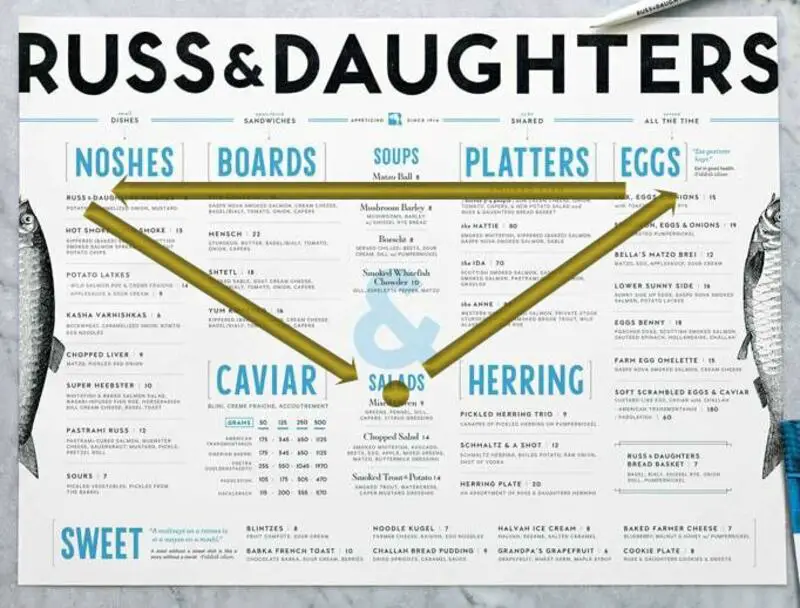
2. Sneaky pricing trickery
One way to encourage you to spend more money is by making the menu prices as unnoticeable as possible. Here are a couple of examples of common psychological pricing tricks you might have seen restaurants using:
- Nested pricing: Successful restaurants use nested pricing, where the price is discreetly after each meal description in the same font. This makes your eyes glide right over the price instead of focusing on it.
- Avoiding money symbols: Currency indicators subconsciously remind diners that they’re spending money and can even make them feel like they are spending more than they are. This is why savvy venues use a common restaurant psychology trick and soften the price by eliminating the pound/dollar sign completely.
- Decoy pricing: Many retailers use the decoy effect (also known as price anchoring), but in restaurants, it’s a simple way to sell you more expensive wine or food items. The decoy effect is about creating the perception of value. Here’s an example: If there are two bottles of wine on a menu for £19 and £29, most people would choose the cheaper one. However, if this list now has a £45 bottle on it, most of the time people will go for the £29 one. The perceived value of the £29 bottle has now changed. Something you may not have bought because the price seemed too high now suddenly appears of value — and less expensive.
3. Fancy meal descriptions
Another restaurant psychology trick is to use very selective, descriptive language in the menu descriptions. Many diners will make their final decisions off on this information. Descriptive menu labels lead to customers feeling more satisfied with their meals, and appetising descriptions can also offset a high price. In fact, research shows that adding an enticing description to a menu item can increase sales by 27%.
This often includes using inviting adjectives, like ‘line-caught’ or ‘sun-dried’, that will feed the imagination and get your taste buds tingling. Another example includes using location or foreign language to suggest quality and authenticity. For example, a menu might have ‘Pulpo a la Gallega’ instead of ‘Spanish Octopus’ or ‘French Onion Soup’ instead of just ‘Onion Soup’.
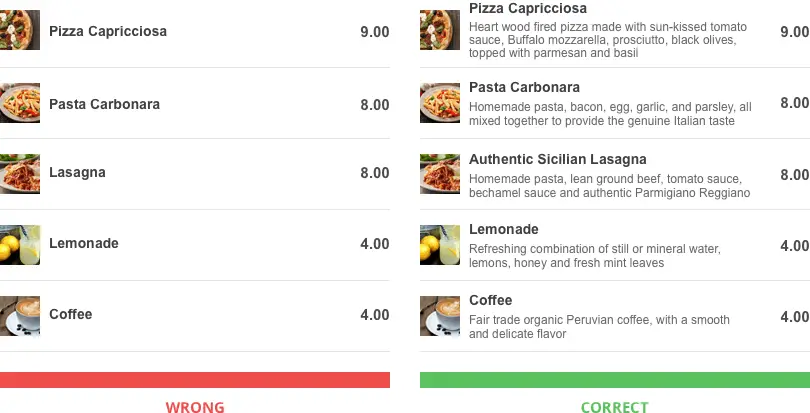
4. Appetite triggering colours
People respond to colours in emotional, subconscious ways, so restaurants often use them wisely to make you spend more. Warm colours like red, yellow, and orange capture attention and trigger appetite. These are often used to attract attention to specific areas of a menu and make you hungrier. This then leads you to order more and spend more money.
5. Using photos sparingly
Have you ever been reading a restaurant menu and wishing it had more photos to help you decide what to order? A lack of photos can sometimes be frustrating for customers but this is actually an intentional restaurant psychology trick.
Excessive use of food photos is typically associated with low-end, cheap venues. Therefore, upscale restaurants usually avoid photos on menus completely. However, one photo per page has been shown to increase sales by up to 30%, especially at casual, affordable eateries.
If you are interested in learning more about in the science (or art) behind restaurant menus, check out May We Suggest: Restaurant Menus and the Art of Persuasion by Alison Pearlman.
Restaurant psychology tricks the waiting staff use
In addition to carefully engineered menus, the waiting staff also have some psychological tricks in their sleeves to make you order more. Let’s reveal some of their secrets!
6. Verbal prompts
Research shows that you’re more likely to order a side dish or other extras when the server verbally prompts you. “Would you like a side of fries with that?” is a classic upselling move and one of the most common restaurant psychology tricks we’ve all heard when eating out. And of course, the answer is usually yes.
But when your meal shows up, you might find that you’ve ordered much more food than you can actually eat. And when you get the bill, you might also see an unexpected bump in the price tag for something that you thought was included in the cost of your meal.
Another typical example of this is the waiting staff asking “Still or Sparkling?”. This automatically guides you toward paying for bottled water and makes you less likely to ask for tap water.
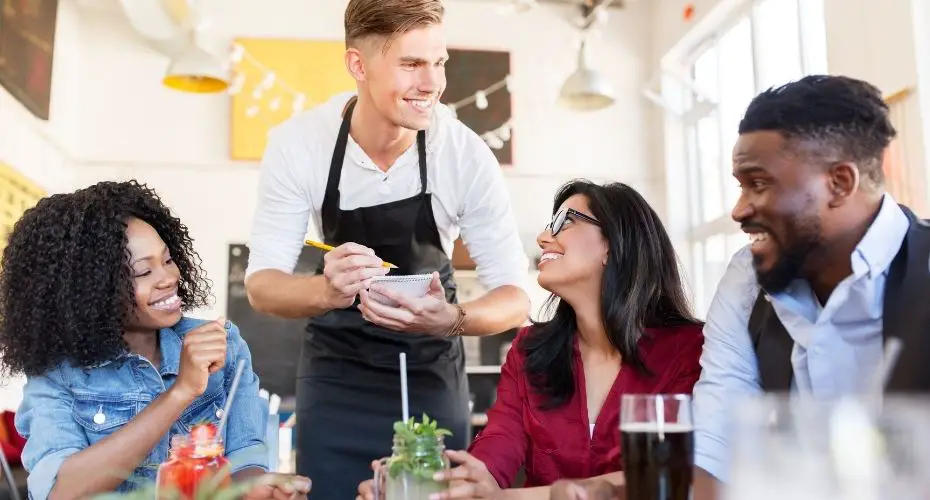
7. Techniques to keep you ordering more drinks
Alcoholic drinks tend to have a high profit margin for restaurants so the waiting staff make sure to use some subtle tricks to make you order more. Here are some of the common tactics that they use:
- Two-straw trick: Frozen drinks such as margaritas, usually take longer to finish than regular cocktails, so servers might put two straws in frozen drinks to make customers drink them faster – and be more likely to order a second round.
- Filling your glass: If you have ordered a bottle of wine on your table, the waiter/waitress will make sure your glass stays full by regularly filling it for you. This is to make you finish the bottle while you’re still eating, to make sure you order another one.
- Salty snacks: Free snacks such as salted peanuts seem like a nice thing for the restaurant to do. But, in reality, they’re usually provided to provoke thirst and make you order more drinks.
8. Dessert cues
Many times diners are too full to consider dessert when a server offers the menu. However, smart servers will have planted the idea of dessert at the beginning of the dining experience.
They may leave dessert menus on the table for you to read throughout your dining experience. Alternatively, they can even have you walk past a dessert display before you reach your table. As a result, you’re more likely to have the dessert in the back of your mind from the beginning. Throughout your main meal, you’ll be more likely to save room so you can splurge on that sweet treat.
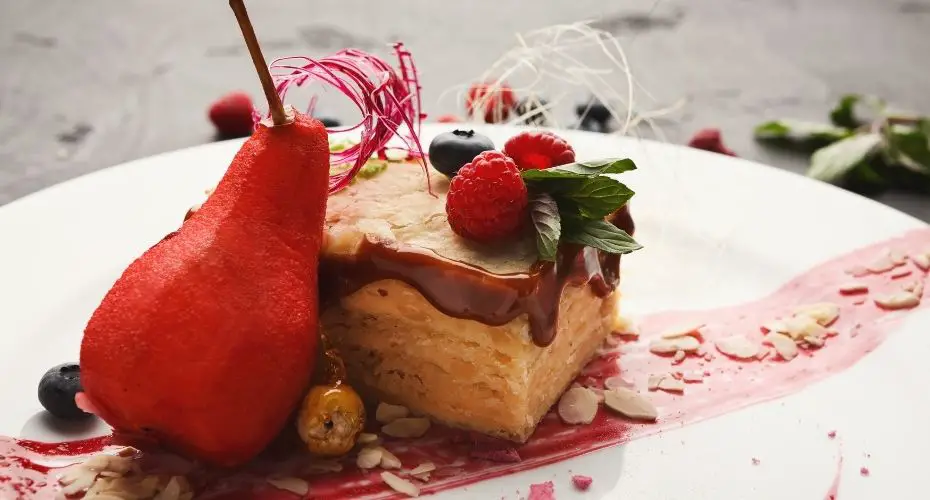
How restaurant environment makes you spend more
Further to the sneaky menu tricks and the waiting staff’s behaviour, the actual restaurant environment can subconsciously impact how much you spend in a restaurant. Let’s have a look at some restaurant psychology tricks used to set the mood for spending more.
9. Classical music
While fast-food restaurants use fast-tempo music to make customers order, eat and leave faster, high-end restaurants focus on slower music. Curating a more cultured atmosphere with classical music is a widely-used tactic in fine dining establishments. At no cost to the restaurant, the music signals to the customer that, just like the atmosphere, the food is exquisite—and worth whatever price.
A study published in the journal of Environment and Behaviour also looked into the effect of musical style on restaurant customer spending. The researchers found that playing classical music in the background led to people being prepared to spend more. Interestingly, less sophisticated pop music caused diners to spend 10% less on their meals.
10. Carefully selected plates and cutlery
Another often-used restaurant psychology trick is carefully selected plates and cutlery. According to a study from 2013, we associate heavier plates and cutlery with expense. Therefore, we tend to view meals eaten off them as more luxurious and enjoyable. This then makes are more likely to accept a bigger price tag in a restaurant.
In addition to this, many restaurants take advantage of the “Delboeuf illusion”, which is when two identical circles look different based on the size of the circles around them. What this means in practice is that larger plates can trick you into thinking you are still hungry and have room for dessert.
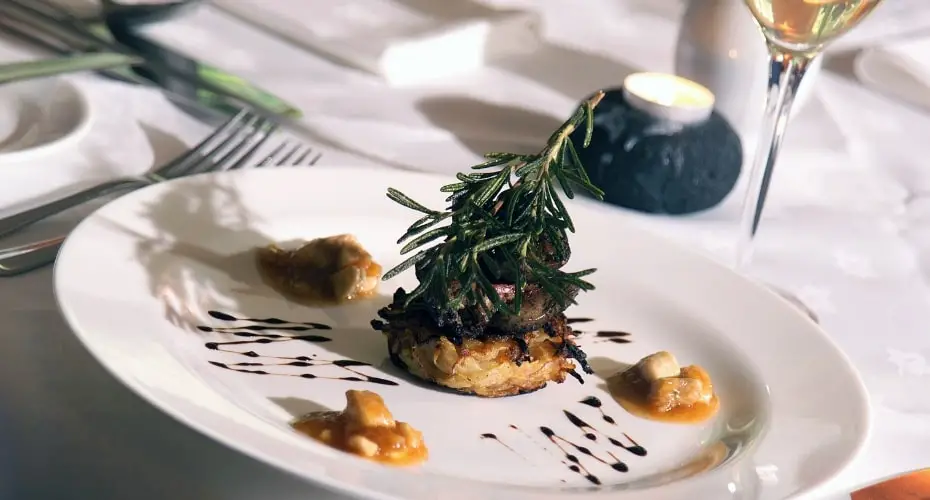
11. Restaurant decor
Decorations aren’t just simple tools for making a restaurant look good, but are effective instruments for having an impact on customers. Carefully chosen restaurant décor can attract more customers, influence appetite and, as a result, make us spend more.
To sell more drinks and appetisers, savvy restaurants usually have comfortable chairs or sofas to create a homey atmosphere and prompt you to spend more time at the restaurant and order some more food or drinks.
As discussed as part of the menu tricks, colours can have a big influence on people, often subconsciously. While warm colours tend to increase appetite, green can contribute to a relaxing atmosphere and make you spend more time at a restaurant – and therefore also more likely to spend more.
How to avoid falling for the restaurant psychology tricks
Next time you’re going to a restaurant, take a look around. See if you can point to all the ways your experience has been crafted by industry experts. It may add a whole new level of intrigue to eating out.
Discovering you’ve fallen for these restaurant psychology tricks engineered by the industry may make you feel a bit uneasy, but perhaps the end result isn’t so bad. For most people dining out isn’t a daily experience but something reserved for a weekend or a special occasion when you are prepared to spend the money to enjoy your time anyway.
Unless you are struggling financially or want to do an extra push towards a specific financial goal, you can just enjoy your occasional restaurant experience. It can still be useful to set a budget for your restaurant trip or night out to ensure you don’t get tempted to spend more than you should.
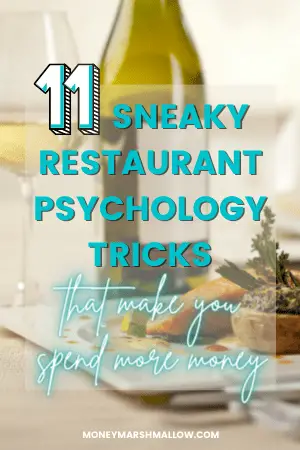
Money Marshmallow is reader-supported. When you buy through links on our site, we may earn an affiliate commission.
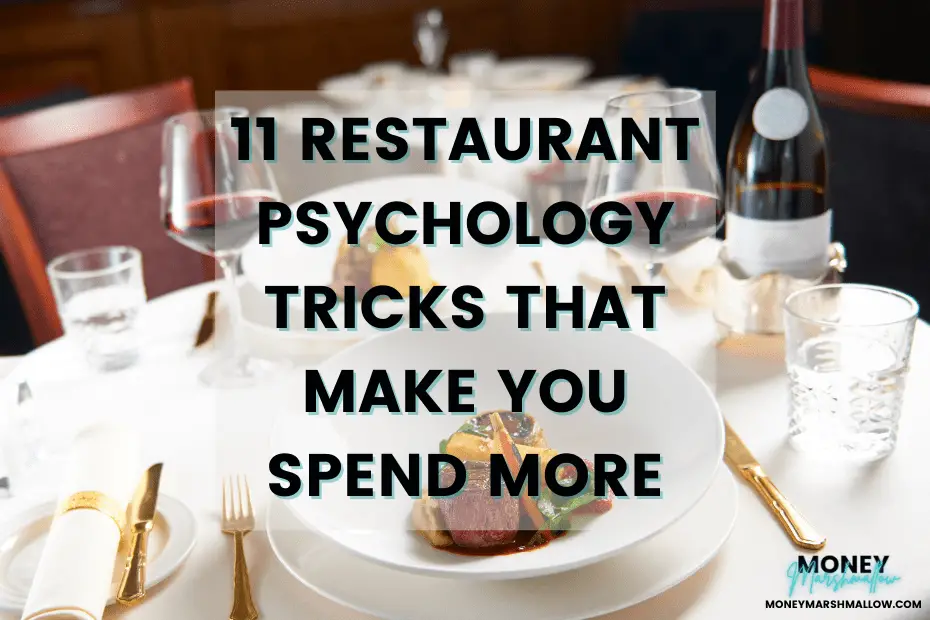

Oh, wow! These all make so much sense. I’ll definitely be mindful next time I dine out. Thank you so much for sharing!
Thanks for your comment, glad you found it interesting!
Interesting article, I thought I was pretty shrewd with my frugal mindset but some of these got me.
It can certainly be difficult to spot some of these restaurant psychology tricks when dining out!
never knew so many things. very informative. thanks for sharing
Thanks! Glad you found this useful 🙂
Amazing article. I will be taking looks around to see if I notice something…
Thanks and good shout – it’s good to be mindful of these tricks when visiting a restaurant 🙂
This article gives lots of ideas on what to look for while eating out at restaurants. Thanks!
Thanks for your comment, Christa!
I don’t dine out very often, but this was such an enjoyable read. I would have never thought of the two straw thing, but wow… so true!
Thanks – I’m sure you’ll look at things differently next time you dine out!
whoa, I had no idea about half of these. no wonder people are always saying not to go out to eat if you want to save money. there are all these tricks! thanks for sharing!
Yep exactly – eating out is already more expensive than cooking at home but restaurants sure try to use all their psychological tricks to make us spend even more.
Well, a few those have worked on me.
It can certainly be difficult to avoid some of these restaurant psychology tricks!
Thanks for the tips. My wife and I often split meals at restaurants to save both money and calories. I’m adding this article to my Fawcett’s Favorites this Monday.
Dr. Cory S. Fawcett
Financial Success MD
Thank you, that’s much appreciated! Splitting meals in a restaurant definitely sounds like a good idea to cut the costs as well as calorie consumption!
What a great article, thanks for such helpful information!
Thanks – glad you enjoyed it! 🙂
Interesting! I’ve never considered how much thought probably goes into menu construction, not unlike any other form of advertising. I am a sucker and usually ask the waiter/waitress for recommendations. And then I spend too much on booze while I’m enjoying my meal!
Absolutely, these psychology tricks are very common especially in high-end restaurants. Advertising makes you want to visit a restaurant while smart menu engineering ensures you order the items with highest profit margins 😉
Ugh these totally all get me too!